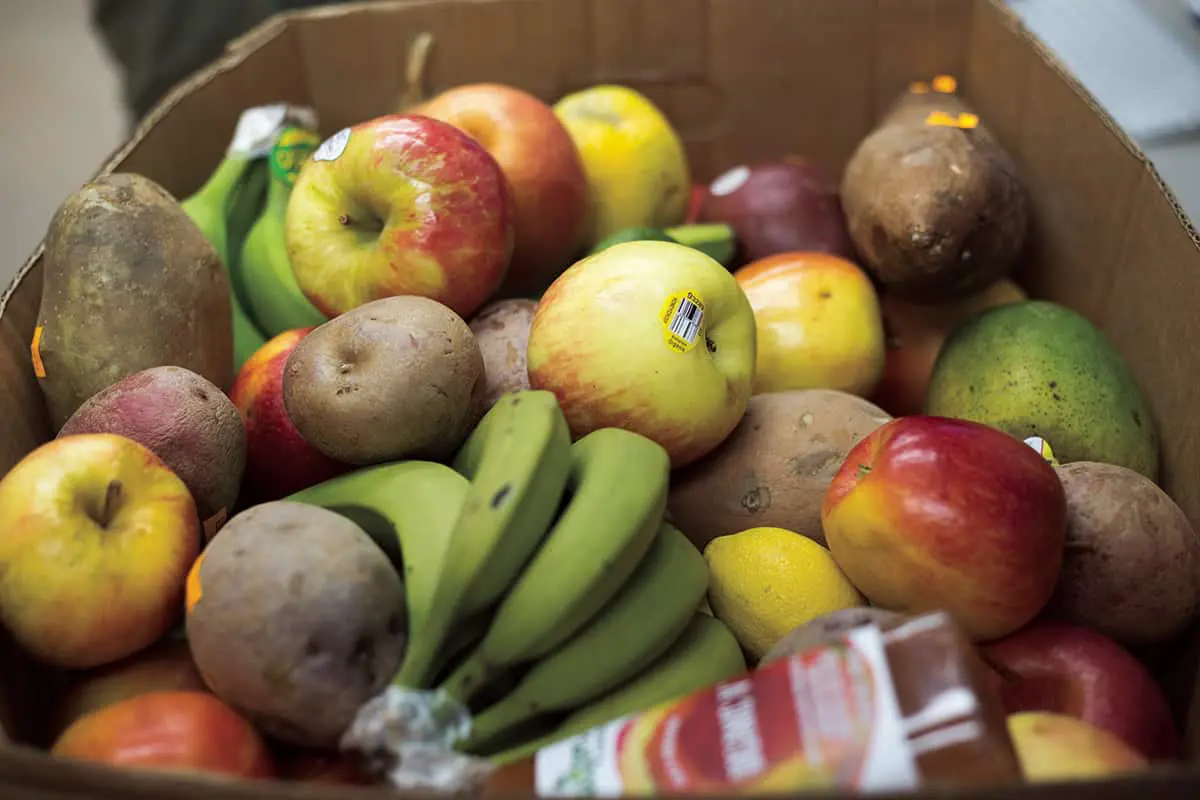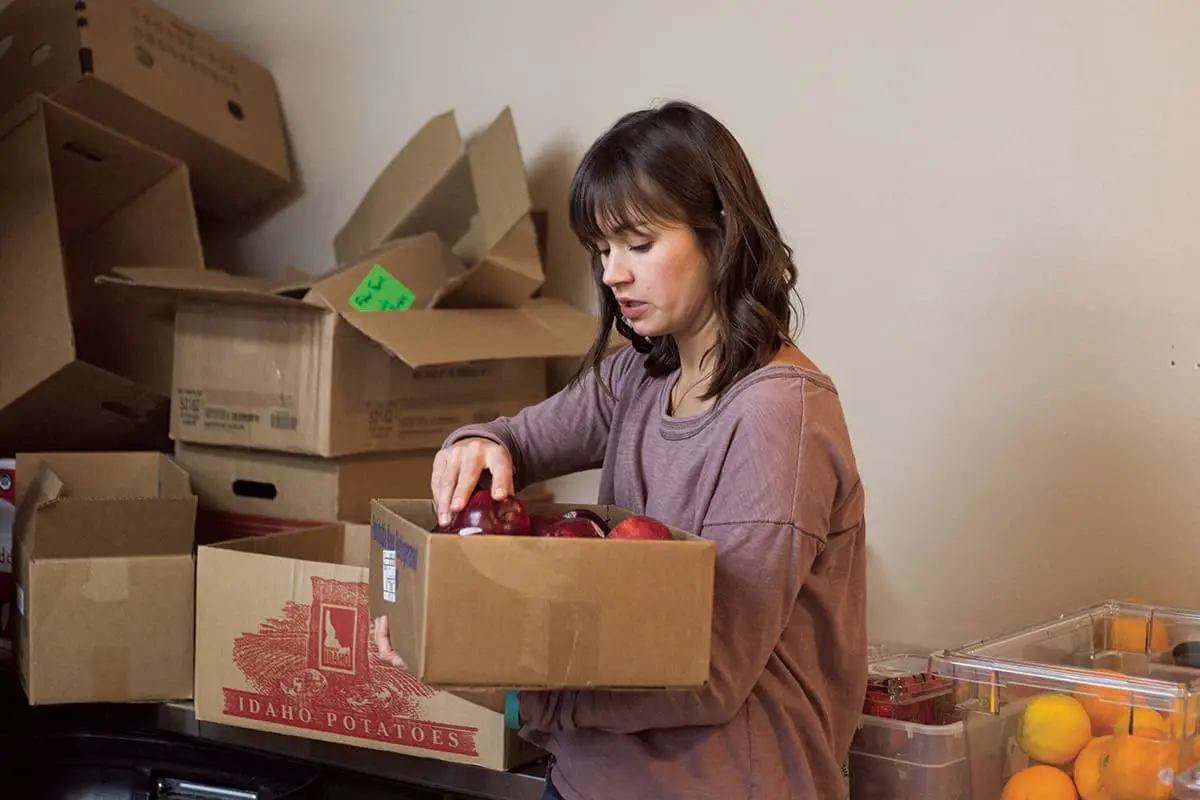By Deb Barracato // Photography by Ashley Cooper
—
Jeske Gräve pulled up to work one morning with 700 pounds of bananas in her car, but it didn’t faze her coworkers. At Hole Food Rescue, they expect this sort of scenario. To celebrate the bounty, Ali Dunford and Hannah Cooley donned the organization’s signature banana suits for an impromptu dance to Gwen Stefani’s “Hollaback Girl.”
“This $%*√ is bananas, B-A-N-A-N-A-S!”
But the festive atmosphere in the office and sorting hub off South Park Loop in Jackson belies the seriousness of what Hole Food Rescue has accomplished in the past five years. Dunford and Gräve, co-executive directors, recently published their first impact report and the numbers added up to clear success.
On average, they collect 20,000 pounds of food every month, enough to fill four Westbank Sanitation trucks or feed one person three meals a day for 15 years. The 25 organizations they supply with food, and the estimated 1,000 people they reach each week, may be the obvious beneficiaries and the organization’s primary focus, but the effect on the entire Teton community goes much deeper.
Social Sustainability
Perhaps it’s no surprise in a looks-obsessed culture, but ugly produce rarely sells, which leaves tons of edible and nutritious food picked over and destined for rot. Additionally, arbitrary expiration and sell-by dates on canned goods and packaged products leave stores legally unable to sell still-safe and palatable food. Each year, Hole Food Rescue collects and distributes more than one million dollars’ worth of excess nutritious food, primarily fresh fruits and vegetables, dairy products, and artisan breads, with much of it going to vulnerable children and seniors.
The U.S. Department of Agriculture estimates that 13 million children in the country live in food insecure households. A lot of those children have working parents with incomes above the poverty line. Yet, for many families, basic nutrition needs fall behind monthly bills and unexpected expenses. In Jackson Hole, 13.5 percent of the county’s residents often or sometimes wonder when and where they will get their next meal.
Since 2015, Hole Food Rescue has eliminated some of that uncertainty for students in Teton Literacy Center’s afterschool program. Laura Soltau, the organization’s executive director, says the fresh fruit and vegetable snacks provided by Hole Food Rescue make it possible for students to focus on their academic tasks, with a notable improvement in concentration. The success of the partnership and the obvious benefits to the children led to the formation of additional partnerships with other local youth programs, allowing Hole Food Rescue to directly feed more than 250 kids each week.
Environmental Sustainability
A shocking 40 percent of all food produced in the United States gets wasted, squandering an estimated $161 billion each year. Globally, unconsumed food accounts for an estimated 3.3 billion tons of greenhouse gases released into the atmosphere annually. Hole Food Rescue diverted 608,826 pounds of food from the local waste stream between June 24, 2013, and December 31, 2016, preventing the emission of an estimated 451,073 metric tons of carbon dioxide—roughly the same amount 481 million pounds of burning coal would generate.
By intercepting the food that 23 local grocery stores and restaurants, and various vendors at the farmer’s market, don’t sell before it goes into the dumpster, Hole Food Rescue also saves the county the cost of trucking it 100 miles to the Bonneville County landfill in Idaho, plus the fees for disposing of it there. “In a way, we’re really a waste management organization,” Gräve says, explaining that food is the single largest municipal waste source, adding that anything they collect but deem unfit for human consumption becomes animal fodder or compost.
The banana bonanza inspired a menu item at the organization’s third-annual awareness event, the Million Pound Party, this past August, where attendees made their own smoothies using the Hoback Sports bike-powered blender. The event fed more than 350 people with rescued food and created less than one can of trash. About 15 staff members and volunteers showed up in banana suits the following weekend at Old Bill’s Fun Run, proving that this bunch takes to heart one of their core values: Always have fun.
Community Involvement
Hole Food Rescue relies on approximately 100 volunteers who spend more than 3,000 hours yearly picking up, transporting, sorting, weighing, logging, and distributing food seven days a week. Hole Food Rescue hosts weekly volunteer orientations that give prospective volunteers an overview of the process and the opportunities to get involved. Visit holefoodrescue.org for more information.
In Teton Valley, Idaho, the Community Resource Center operates a food rescue program with a similar mission. With the help of about 18 volunteers, they currently redistribute around 2,000 pounds of unsellable food per month from Broulim’s, 460Bread, and Big Hole Bagels to the Family Safety Network, Seniors West of the Tetons, the Teton Valley Food Pantry, and the Hispanic Resource Center. Contact Megan O’Brien, the executive director of CRCTV, at megan@crctv.org or 208-354-0870 to inquire about volunteer opportunities.


